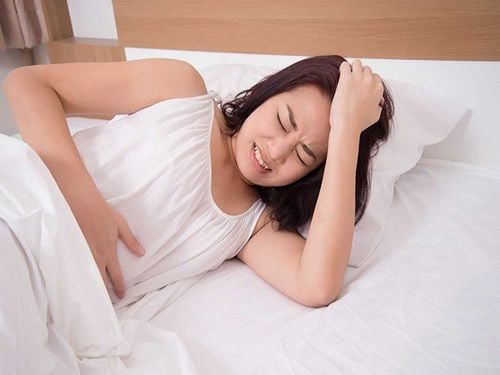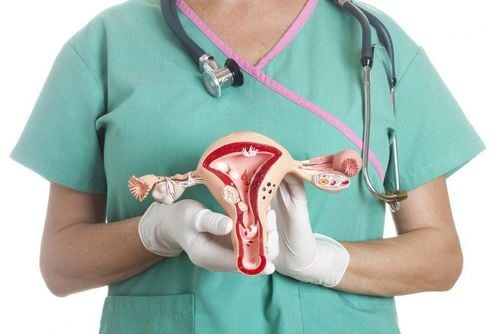This is an automatically translated article.
The article was written by Dr. Pham Thi Hong Hoa - Diabetic Endocrinologist - Department of General Internal Medicine - Vinmec Times City International HospitalA woman's life goes through many stages, of which 1/3 of life is menopause. Before menopause, a woman will go through perimenopause, usually starting at the age of 41-45. Perimenopause can be as short as 5-7 months, but it can also last 2-4 years, and for some people, it can last as long. 5-10 years. This is a transition, a natural physiological phenomenon, not an event. Some people go through this phase peacefully. So what should be prepared so that even after perimenopause - menopause, we are still beautiful, young, full of happiness and have a fulfilling life. You need to have knowledge about perimenopause - menopause.
1. What is menopause?
Menopause is the complete and permanent cessation of menstrual bleeding due to a gradual decline in ovarian function, a decrease in the ovaries and a cessation of the hormone estrogen. A drop in estrogen can lead to perimenopause. Perimenopause can occur 3 to 5 years before menopause. From the age of 41 to 45, up to 85% of women experience perimenopausal syndrome at different levels: Mild or severe depending on the woman's neurological, mental, and psychological state. In mental workers, the phenomenon of perimenopausal disorder is more severe than in manual workers. The age of natural menopause is from 44 to 53. In Vietnam, the age is 48 ± 3. Menopause before 40 - 45 years old is early. If before the age of 40, it is very early; often seen in people who smoke, drink alcohol, have had radiation therapy, have immune disorders, have premature ovarian failure, have had a hysterectomy. Late menopause is after the age of 55. After menopause, women often have symptomsVagina and urethra are small. Osteoporosis. High risk of cardiovascular diseases (atherosclerosis).

Mãn kinh gây nguy cơ xơ vữa động mạch
2. Signs of perimenopause
Menstrual disorders: Menstrual irregularities, irregular periods, low menstrual flow, sometimes stopping suddenly Premenstrual breast disease: Breast pain, possibly with a solitary benign breast nucleus (Adenome). Acne may occur due to a decrease in endogenous progesterone. Decreased sex drive and decreased fertility. Susceptibility to breast cancer with a high frequency, due to decreased physiological progesterone.3. Real signs of a woman's menopause
There may be no symptoms.Possible symptoms due to estrogen deficiency:
Vasomotor disorders: There are hot flashes, red face, hot flashes in the upper body from the head to the neck, down the chest, hot body. Body palpitations, sweating, chills, insomnia, hot and cold. These symptoms are common at night and during the hot season. Each hot flash usually lasts 10-20 minutes. About 50-85% of menopausal women experience these symptoms, of which 15% are uncomfortable. Psychiatric disorders: Anxiety, nervousness, often heart palpitations, mood swings, irritability, loss of composure, loss of confidence, easily depressed and possibly depression. Inability to concentrate, memory loss, forgetfulness, the onset of symptoms of Alzheimer's disease. Changes in appearance: Decreased estrogen reduces and loses subcutaneous fat, making the skin no longer shiny, becoming wrinkled, melasma. The breasts are also flat and saggy. Instead, fat accumulates in the viscera, thighs, and waist, making the abdomen bigger, gaining weight, and making the body bulky. One of the symptoms of menopause in women is changes in the body: fat accumulates, causing the abdomen to enlarge, weight gain, body mass,...
Changes in reproductive organs: + Due to a decrease in concentration Estrogen level → Ovaries, uterus, and vagina shrink.
+ The glands minimize and secrete less mucus, so atrophy of the vaginal mucous membrane → Vaginal dryness, painful intercourse, easy infection due to bacteria.
+ Decreased sexual pleasure and desire.
Minimizing the urinary tract: The urethra is short, the bladder muscle tone is poor, the bladder neck muscle is weak, so it is easy to urinate, urinary frequency, urine deposition in the bladder, easy urinary tract infections. Effects on the skeleton: Estrogen deficiency reduces calcium absorption into the bones, leading to a decrease in bone mass, osteoporosis and bone loss, subsidence of the vertebrae, and a decrease in height. You are prone to spongy bones, brittle bones, easy fractures below the radial and femoral neck. The risk of osteoporosis is increased in women with early menopause, surgical menopause, lean women, a diet low in calcium and vitamin D, high in caffeine and alcohol, smoking, sedentary lifestyle, and internal disease. other details. The risk of osteoporosis increases in women with early menopause, menopause due to surgery,...
Cardiovascular disease: 2 - 4 times higher than in non-menopausal women. We are prone to high blood pressure, coronary heart disease, increased risk of blood clots. Increased dyslipidemia: decreased HDL-C (good cholesterol), increased triglycerides, increased total cholesterol, increased LDL-C (bad cholesterol). Cardiovascular disease: Increase 2-4 times compared to people who have not yet menopause.
Cancer: Increased risk of breast cancer, cervical cancer.
4. How to treat menopause?

Mầm đậu nành giàu isoflavon giúp cân bằng nội tiết tố nữ
Actively exercise, every day at least 30-60 minutes. Dietary fiber, low fat, high in legumes. Maintain regular sexual activity Increase relaxation and stress relief. Sunbathe daily, every day about 1h, before 9am. Reduce drinking alcohol, coffee, quit smoking. Menopausal women need to increase stimulation of the body to synthesize female hormones by making lifestyle changes.
- Female sex hormone replacement therapy can be used:
4.1 Hormone replacement therapy Synthetic estrogen replacement hormone therapy.
Benefits of this therapy :
Reduce vasomotor symptoms, hot flashes. Reduce skin symptoms. Improve symptoms of atrophy in the genital system. Prevention and treatment of osteoporosis takes a long time. Prevention of cardiovascular disease (40-50% risk reduction). Other benefits: Increase sex drive, increase brain perfusion, increase memory, reduce risk of Alzheimer's, may prevent stroke * Side effects of hormone replacement therapy:
Endometrial hyperplasia. Risk of endometrial cancer, breast cancer. Hypertension. Thrombosis (increased blood clotting especially in smokers). Breast tenderness, weight gain due to water retention. The therapeutic effect is clearly achieved when compensating for the loss of endogenous sex hormones during menopause through the use of “hormone replacement therapy”, which uses hormones of synthetic origin. However, this therapy must be available with a prescription and under the supervision of a doctor.
4.2 Plant-based estrogen replacement therapy (Phytoestrogens): Some studies found in soybeans, cereals, lentils, garbanzos beans have isoflavones that have the same effect as synthetic estrogen but weaker breast letter. Long-term effect: Reduce atherosclerosis, reduce blood vessel damage, increase epithelial cell growth, decrease smooth muscle cell growth. Majority of lipid metabolism indices improved The improvement in HDL and LDL was dose proportional. Protein composition and isoflavones are both important for lipid metabolism. Relieves symptoms of perimenopause/menopause. Prevent osteoporosis, protect the heart.













